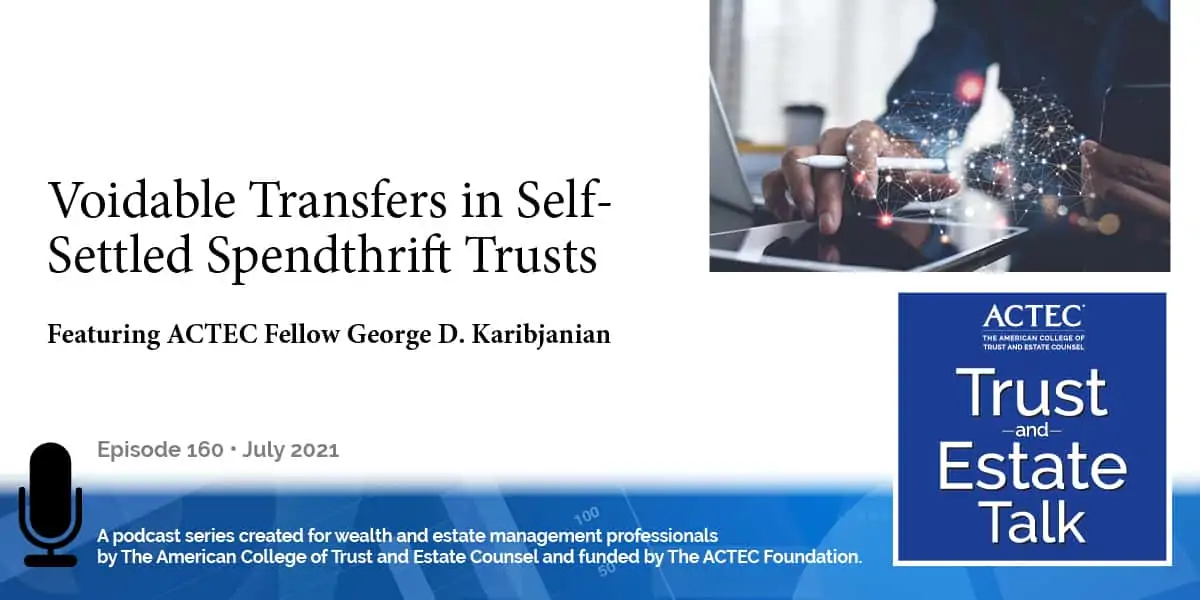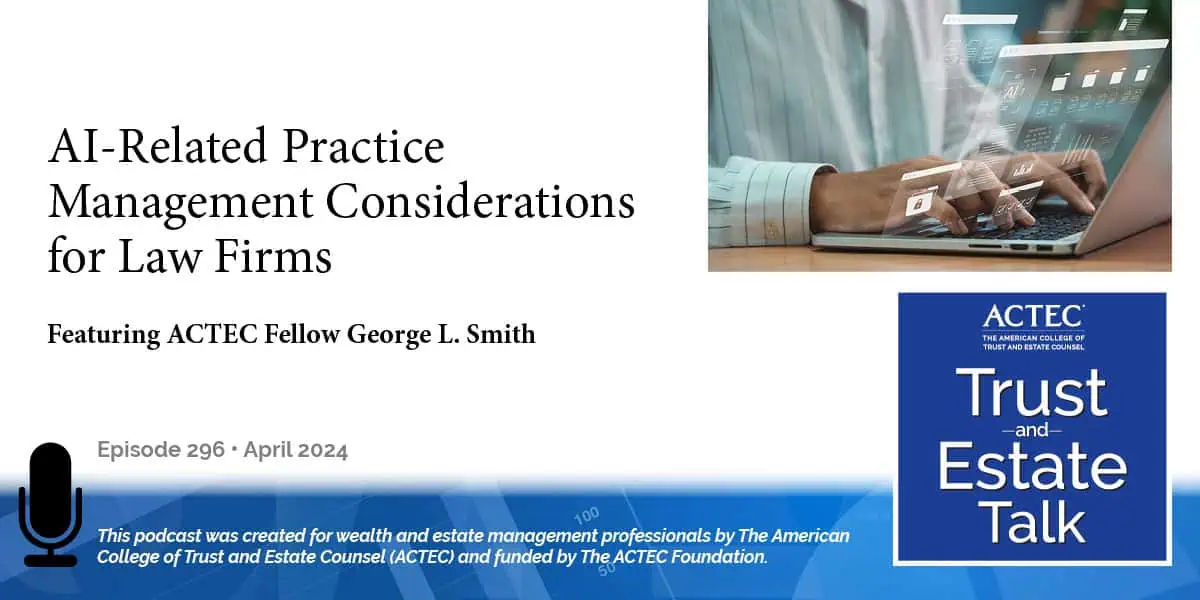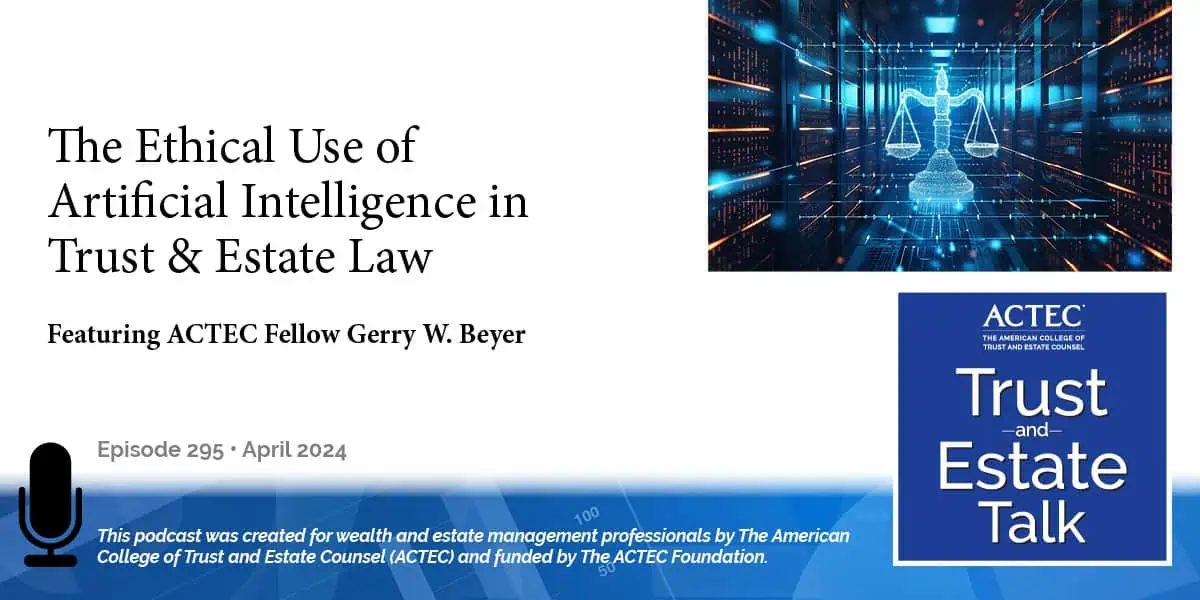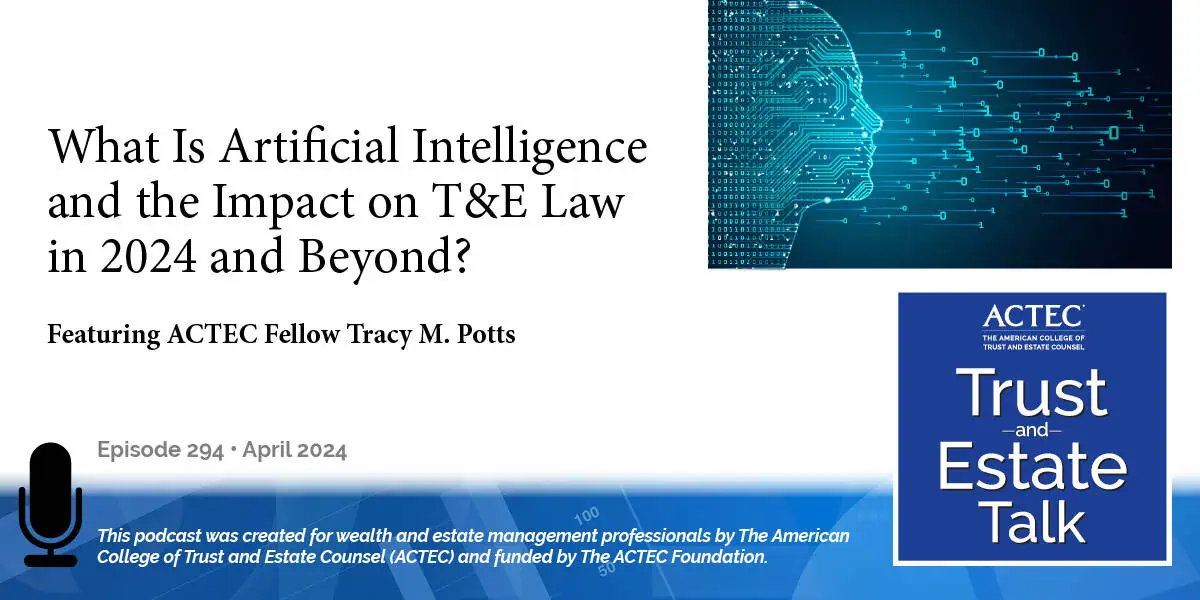Voidable Transfers in Self-Settled Spendthrift Trusts

“Voidable Transfers in Self-settled Spendthrift Trusts,” that’s the subject of today’s ACTEC Trust and Estate Talk.
Transcript/Show Notes
This is Ed Beckwith, ACTEC Fellow from Washington, DC. The Wyoming legislature has introduced House Bill 64. This would specify when claims involving fraudulent transfers to qualified spendthrift and other irrevocable trusts are extinguished. To tell us more about this bill and to discuss, more generally, the statutes of limitations applicable to voidable transfers in self-settled spendthrift trusts, you’ll be hearing today from ACTEC Fellow George Karibjanian, of Boca Raton, Florida. Welcome, George.
Thank you. So, we’re going to do a quick overview of – what are the statutes of limitations under most states’ Fraudulent Transfers Act or Voidable Transfers Act? We’re going to talk about then, why these have changed over the years – an important Supreme Court case from about almost 33 years ago – how that has affected the statute of limitations, what Wyoming is trying to do, and is it a good idea?
Uniform Fraudulent Transfer Act
So, let’s first start with the basics. Forty-four of fifty-one jurisdictions have adopted, through 2004, the Uniform Fraudulent Transfer Act. Since then, the Uniform Law Commission has revised the Fraudulent Transfer Act to call it the Uniform Voidable Transactions Act, on which I have lectured ACTEC and other groups about the dangers of this law, which we’ll talk about in a bit.
But under the UFTA, which is what we will call it, the basic statute of limitations is this – if you’ve put property into sort of what we would call a self-settled asset protection trust or domestic asset protection trust, you transfer property into one of those. There is a statute of limitations after which a claim cannot be brought; and that statute is generally four years after the transfer was made or one year after the transfer could reasonably have been discovered by the claimant. And this is basically under UFTA Section 9A; and everything relates back to UFTA Section 4, which is basically how you bring a claim. I think most people are familiar. In most states the test is, was there an effort to hinder, delay, or defraud the creditor? So, we’re looking at that – what we’ll call the 4-1 period.
So, fast forward – in 1997, Alaska was the first state to bring in domestic asset protection trust legislation. As I think I described at the committee meeting, they were the Resorts International of Atlantic City back in 1978, when they were the only game in town. Since then, 19 different jurisdictions now have asset protection trust legislation.
So, pretty much, it’s not necessarily the law, is now suddenly states have to market themselves. Why do you need to bring your asset protection business here, and what is the incentive they’re doing? So, 9 jurisdictions of the 19 have actually lowered that 4-1 term. And in those jurisdictions, it has been lowered to two years from the date of the transfer or six months after it could have reasonably been discovered; and those jurisdictions would be Hawaii, Indiana, Michigan, Mississippi, Nevada, Tennessee, Utah and South Dakota.
Ohio has taken it one step further. Ohio’s legislation lowered the first term, from the time of transfer to a year and a half.
Wyoming Legislation – House Bill 64
So, with that, what’s Wyoming done? Well, Wyoming’s legislation, House Bill 64, has two components to it. First, it would lower the 4-1 term to 2 and 0.5, two years from the time of the transfer, six months or half a year when it reasonably would have been discovered. But then it adds another element. And the other element it adds is that the settlor of the trust, we believe – it’s not clear under the legislation but I believe it’s going to be the settlor – can publish a notice in a local business newspaper that an asset protection trust has been created. Plus. if there are any creditors, known or reasonably ascertainable creditors, they would be required to serve those creditors with notice. After 90 days has passed, claims are extinguished. So, you could lower that term from two years to 90 days.
Now, if that 90 day and publication sounds familiar, it should for those in many jurisdictions because that follows probate notices regarding creditors. And a lot of this stems from the 1988 United States Supreme Court case Tulsa Medical Center v. Pope. And that case stood for the Tulsa Professional Collection Services, Inc. v. Pope. That case stands for the proposition that if an estate knows or reasonably knows that a creditor exists, the publication in the newspaper doesn’t count. It has to actually serve that creditor with notice. Not to do so would violate the due process clause of the United States Constitution.
Since then, states fall into three categories in probate. Either you have no notice, either notice is optional, which is how the Uniform Probate Code provides, or notice is mandatory. You are required to publish; you are required to serve notice. This is how Wyoming, and as we were told at the committee meeting, how Utah – Utah, I think it’s 180 days.
So, the question becomes, is this a good idea? Would you really want to have the settlor notify the creditors in advance? What would that do? A creditor is likely to bring a case. Say, hey – I’m protecting my claim. I’m filing a protective claim in the court.
What if the court decides hey – you owe that money now. You never know what a court’s going to do. I’m conservative when it comes to this. I don’t like to play games. If I don’t have to go to court, I don’t want to go to court. So, if the statute is two years without notice, is there really a benefit from shortening the period? Bottom line is, it’s a marketing tool. It’s trying to get people to go to Wyoming.
I am not from Wyoming. I haven’t been to Wyoming. I’ve flown over Wyoming. But I can tell you it is literally the Wild West when it comes to trust law. The legislature is being very active in trying to make Wyoming the “in place” for people to go for their trust business. For example, the Uniform Decanting Act has 20-plus statutes. Many states’ decanting statutes comprise two pages in the statute book. Wyoming’s is very simple. You can decant whatever you want; however you want, but if the trustee is the beneficiary, you can’t change your answers. That’s it. There are your requirements for Wyoming.
You see, Wyoming is trying to actively market itself for this type of business. So now, that’s great. Should we all be running to Wyoming for our business? Well, it depends. Has your jurisdiction adopted the Uniform Voidable Transactions Act?
Uniform Voidable Transactions Act
Now, let’s talk about that. The UVTA is a very dangerous act when it comes to estate planning. They claim not much has changed between the UFTA and the UVTA, but do not be fooled. That is a blatant misrepresentation. The UVTA adds a Section 10, which is a domicile, which is a jurisdictional statute. Bottom line is, the comments to the UVTA – the comments in Sections 4 – refer back to Section 10, and they basically say the following: If you’re going to another jurisdiction to take advantage of a benefit that your jurisdiction does not have, a transfer to a self-settled asset protection trust would be voidable per se. That’s what the comments state. Not literally, but that is the conclusion.
So, if you’re in a non-UVTA state and you go to Wyoming, great. If you’re in a UVTA state and you go to Wyoming, are you seeking to get an extra benefit? Well, it depends. If you’re in a UVTA state, and the only benefit you’re trying to get is to shorten the creditors’ period, I kind of don’t think they would void the entire trust if a creditor complained. I think, at most, they would make you wait out your domiciliary state’s statutory period for claims.
But if you’re in a non-UVTA state and you’re going or if you’re in a UVTA state that does not have self-settled asset trust legislation and you’re seeking to go there, I think you’re in trouble. Because I think the UVTA would still hold true. Now, keep in mind, I’m not a big proponent on shortening the period; but there may be other benefits for going to Wyoming. So, it’s very important to keep an eye on this and see how the legislature goes, and see then if they do adopt it, whether any other legislatures will adopt this premise.
Thank you, George, for educating us on this asset protection technique.
This podcast was produced by The American College of Trust and Estate Counsel, ACTEC. Listeners, including professionals, should under no circumstances rely upon this information as a substitute for their own research or for obtaining specific legal or tax advice from their own counsel. The material in this podcast is for information purposes only and is not intended to and should not be treated as legal advice or tax advice. The views expressed are those of speakers as of the date noted and not necessarily those of ACTEC or any speaker’s employer or firm. The information, opinions, and recommendations presented in this Podcast are for general information only and any reliance on the information provided in this Podcast is done at your own risk. The entire contents and design of this Podcast, are the property of ACTEC, or used by ACTEC with permission, and are protected under U.S. and international copyright and trademark laws. Except as otherwise provided herein, users of this Podcast may save and use information contained in the Podcast only for personal or other non-commercial, educational purposes. No other use, including, without limitation, reproduction, retransmission or editing, of this Podcast may be made without the prior written permission of The American College of Trust and Estate Counsel.
If you have ideas for a future ACTEC Trust & Estate Talk topic, please contact us at ACTECpodcast@ACTEC.org.
© 2018 – 2024 The American College of Trust and Estate Counsel. All rights reserved.
Latest ACTEC Trust and Estate Talk Podcasts

AI-Related Practice Management Considerations for Law Firms
A discussion for law firms about how to incorporate AI in their practice management, including staff considerations, the “billable hour,” and more.

The Ethical Use of Artificial Intelligence in Trust & Estate Law
A law professor offers insights into the risks, rewards, duties and ethical considerations of lawyers using AI in their T&E practices.

What Is Artificial Intelligence and the Impact on T&E Law in 2024 and Beyond?
A primer on the types and uses of AI, then a deeper dive into the impact on trust and estate law from types to applications to ethical considerations.

